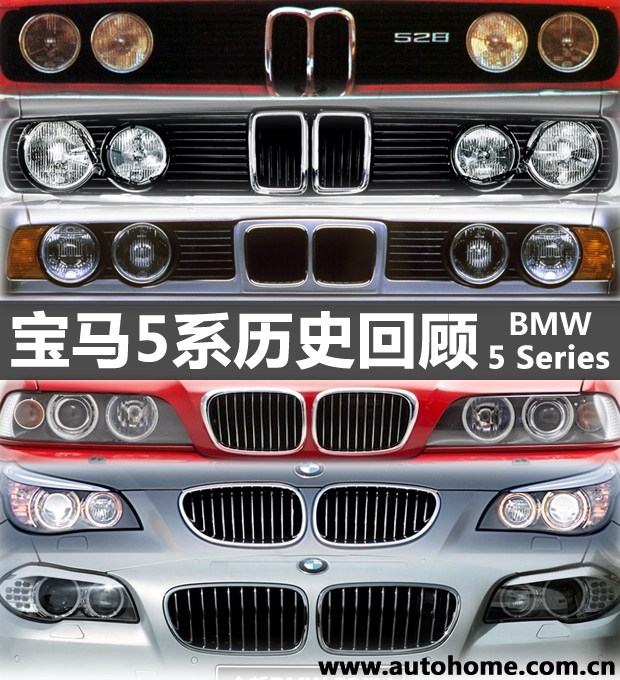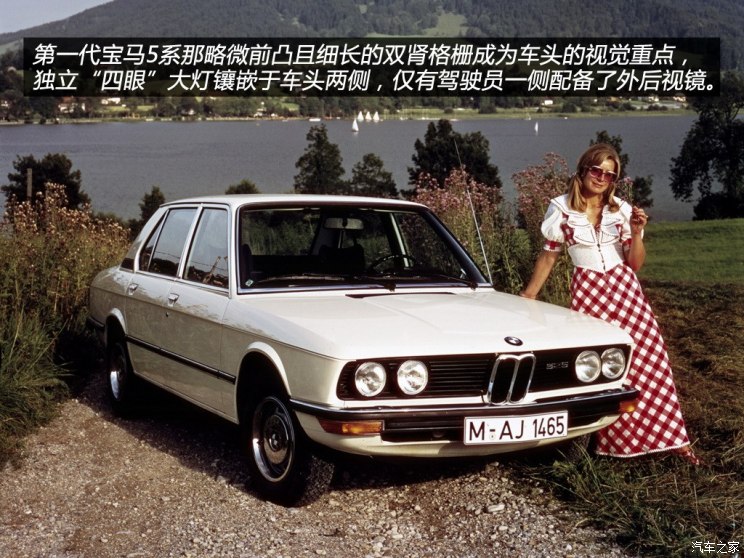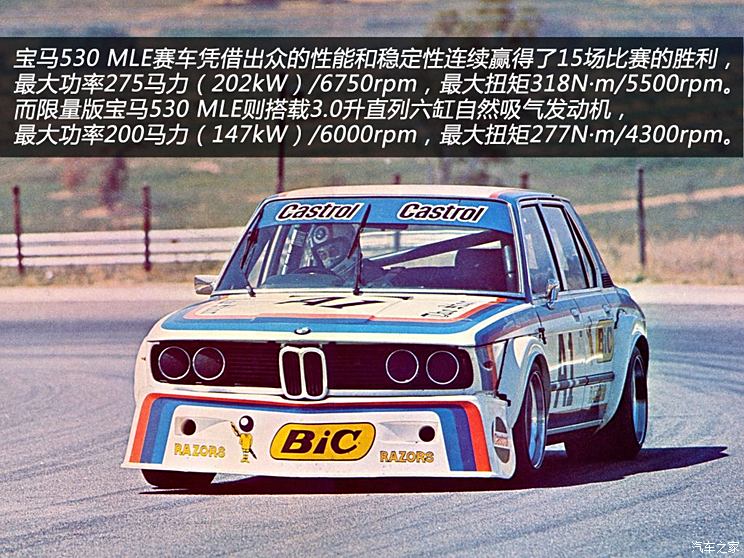41-year History Review of BMW 5 Series from Tradition to Innovation
[Car History] Founded in 1916, BMW (German: Bayerische Motoren Werke AG) is a German company specializing in the production of high-end cars and motorcycles. Its headquarters is located in Munich, Germany … It must have been memorized by senior fans and fans, so we will simplify the complex at the beginning of the article. BMW mainstream cars are divided into three sizes: S(3 Series), M(5 Series) and L(7 Series). Today, we will talk about the development history of BMW medium-sized cars.

The 1st BMW 5 Series (E12): 1972-1984
Master classic design, little-known mysterious car

In 1970, in order to compete with W114 series, BMW commissioned Italian Broadcom () design company to design a new car for it, which was designed by Marcello Gandini, and the BMW 2200 ti Garmisch was born. The 2200 ti Garmisch has a very strong Italian car style. Except for the "double kidney" air intake grille faintly visible in the front of the car, it is difficult for you to associate it with the impression of BMW. Click to enter "Biography of Designers-Marcello Gandini"

However, Gandini used this design style on the 132 and Alfetta at the same time, and BMW seems to be quite dissatisfied with this similar design. In 1972, the test car of the first generation of BMW 5 Series was not what we saw in the production version today, but in the end, BMW followed the master’s design. The existence of Fiat 132 and Alfa Romeo Alfetta also made BMW encounter a lot of problems in promoting the first generation of 5 Series.

In 1972, the first-generation BMW 5 Series (E12) was officially unveiled in China. It adopted a brand-new naming method of "5-Series" (the fifth car series after the concept of BMW New Class), and the "5" in the rear logo represents its car series, and the last two digits represent the displacement. Its birth also opened a brand-new classic design era for BMW. An important feature of BMW-the kidney-shaped air intake grille is like a "pig’s nose" placed in the center of the four round lights at the front of the car. For the cars of that era, the bumper design is still relatively weak, as is the first generation 5 Series, and its windshield is wrapped in chrome decoration to create the atmosphere that luxury cars should have. Like most European car brands in that era, the BMW 5 Series only had a driver’s side mirror.

Compared with the highly recognizable front shape, the rear design of the first-generation BMW 5 Series is too low-key. If the BMW Logo is removed, I am afraid it will be easily mistaken for a French car. Although the design is relatively low-key, there are many bright spots at the rear of the car. The fuel tank cover near the right taillight is an interesting design. The dimensions of the first generation BMW 5 Series are 4600mm in length, 1690mm in width, 1425mm in height and 2600mm in height. Its large window, low waistline design and Hofmeister corner on the C-pillar have become its indelible and eternal classics.

The interior design of the first generation BMW 5 Series is very layered. The air conditioning and radio area in the center of the center console protrudes forward as a whole. A clock is cleverly placed in the center of two air conditioning knobs, and the four-spoke steering wheel with large size and thin grip is quite satisfactory. As a luxury car, the configuration of the first generation BMW 5 Series is not very rich now, but these only configurations just symbolize the positioning of luxury cars in that era, even if it is just a clock.

The first generation BMW 5 Series adopts front and rear semi-trailing arm structure. At first, the vehicle was equipped with manual lifting windows, FM radio and air conditioning system. In 1976, BMW made some improvements to the first generation of 5 Series cars, which enhanced the sound insulation effect of the whole car, and added electric exterior rearview mirrors, steering assistance and front wheel disc brake system. In order to accurately calculate the deformation zone of the vehicle in the event of an accident and ensure the safety of the people in the vehicle, BMW engineers used computer technology extensively in the vehicle design and research and development stage for the first time.

BMW is equipped with various engines for the first generation 5 Series, among which BMW 518 and 520 are equipped with 1.8-liter and 2.0-liter inline four-cylinder engines code M10. Since then, the 2.0-liter inline six-cylinder engine code M20 has replaced the original inline four-cylinder engine on the 520. The in-line six-cylinder engine with the code M30 is applied to the BMW 525, 528, 528i, 530, 530i and 533i, in which the BMW 525 is equipped with a 2.5-liter in-line six-cylinder engine, with a maximum of 145 HP (107kW)/6000rpm and a maximum of 208 N m/4000 rpm, which is matched with the engine at 4 and 5 speeds. Take the BMW 528i as an example, the "I" in the trailer "528i" indicates that its engine is equipped with a fuel injection system.

In the early 1970s, BMW’s business in South Africa just started. Due to the high import tax in South Africa, BMW decided to build a factory in South Africa to assemble and produce BMW 2500 and 2800 cars locally in the form of CKD. However, due to the unsatisfactory sales performance, BMW began to seriously think about the feasibility of expanding the South African market. After much deliberation, BMW finally decided to launch the first generation of BMW 5 Series sedan in South Africa in March 1974. The effect of BMW’s blog was beyond imagination, and its sales performance increased rapidly. At the same time, motor racing and consumers’ demand for high-performance cars make BMW see opportunities. In 1976, a limited edition model named BMW 530mle (Motor Sport Limited Edition) was sold quietly in South Africa. At the same time, it is also the originator of BMW M production version in the future.

In order to qualify for the Republic Day Cup held in 1976, BMW launched a limited edition of 100 BMW 530 MLE in the South African market, which was quickly sold out. In order to meet the needs of consumers, BMW finally increased the output of this car to 201. The car is all painted in white, with a large spoiler under the front, and a small and prominent wheel eyebrow and classic BMW "M" flower at the rear to make it stand out. In order to make it reach the maximum body, the car is made of a lot of aluminum and punched in various parts of the car body to reduce the weight. The steering wheel, Scheel sports seat, BILSTEIN shock absorber and 14-inch BBS Mahel alloy wheels are its exclusive configuration. The BMW 530 MLE adopts the 3.0-liter inline six-cylinder naturally aspirated engine on BMW E3. After training, its maximum power is 200 HP (147kW)/6000rpm and its maximum torque is 277 N m/4300 rpm. The BMW 530 MLE racing car has a maximum power of 275 HP and a maximum torque of 318 N m.. Nowadays, the BMW 530 MLE has long been forgotten. It was born in South Africa, which made many people almost unaware of its existence. At that time, only a handful of 201 limited-edition models were preserved so far.

The first generation of BMW 5 Series can be said to have made great contributions to the development of the whole car series. In order to meet the demand of consumers for sports models, BMW launched a special upgrade service for the first generation of 5 Series cars. Finally, in 1980, BMW simply launched the official sports version of the BMW 5 Series-M535i. The car adopts the same style as the previous 530 MLE. The front of the car is equipped with a large-size front bumper with a mesh opening. The BMW "M" and "535i" logos on the air intake grille mark the particularity of its identity.

BMW "M" flower can be installed on the front bumper and the side of the car body as an option. The logos of "M" and "535i" can also be seen on the black spoiler at the rear, and the "M" color decorative strip at the lower edge of the spoiler reflects the ultimate details that BMW pursues to build this performance car. In addition, the most "dazzling" thing at the rear of the car is the chrome-plated exhaust with the middle and double outlets slightly inclined to the left, which seems to show off to people all the time: "Hey! I am not an ordinary BMW 5 Series! " .

As an important model of BMW M and BMW 5 Series with great historical significance, the 35i is equipped with many exclusive configurations such as three-spoke sports steering wheel, RECARO sports seat and 14-inch alloy wheels produced by BBS. The car is equipped with a 3.5-liter inline six-cylinder naturally aspirated fuel injection engine code M30B35, with a maximum power of 218 HP (160 kW)/5,200 rpm and a maximum torque of 310 N m/4,000 rpm. It is equipped with a 5-speed manual transmission, with a top speed of 222km/h and an acceleration time of 7.5 seconds from 0 to 100 km/h.. From 1980 to 1981, BMW M535i produced 1410 units.

Different from other markets, BMW only launched the "high-end" BMW 530i for the North American market, which comes standard with electric windows, wood grain and leather interior. Due to the requirements of American safety regulations, the first-generation BMW 5 Series was fitted with a specially designed extended bumper after entering the North American market, and the turn signal on the front bumper was moved to the front end of the fender. In order to adapt to the strict emission regulations of the United States, BMW modified this 530i exhaust manifold, but this caused the exhaust of the 530i to overheat, which led to cracking. In 1980, BMW replaced the cylinder head for the owner of the 530i (including the expired warranty period) for free. Since then, the BMW 528i has replaced the previous 530i. From 1972 to 1984, the first generation BMW 5 Series produced a total of 699,094 units. As the first model of the new car series, the BMW 5 Series (E12) has achieved great success in both sales volume and market recognition.